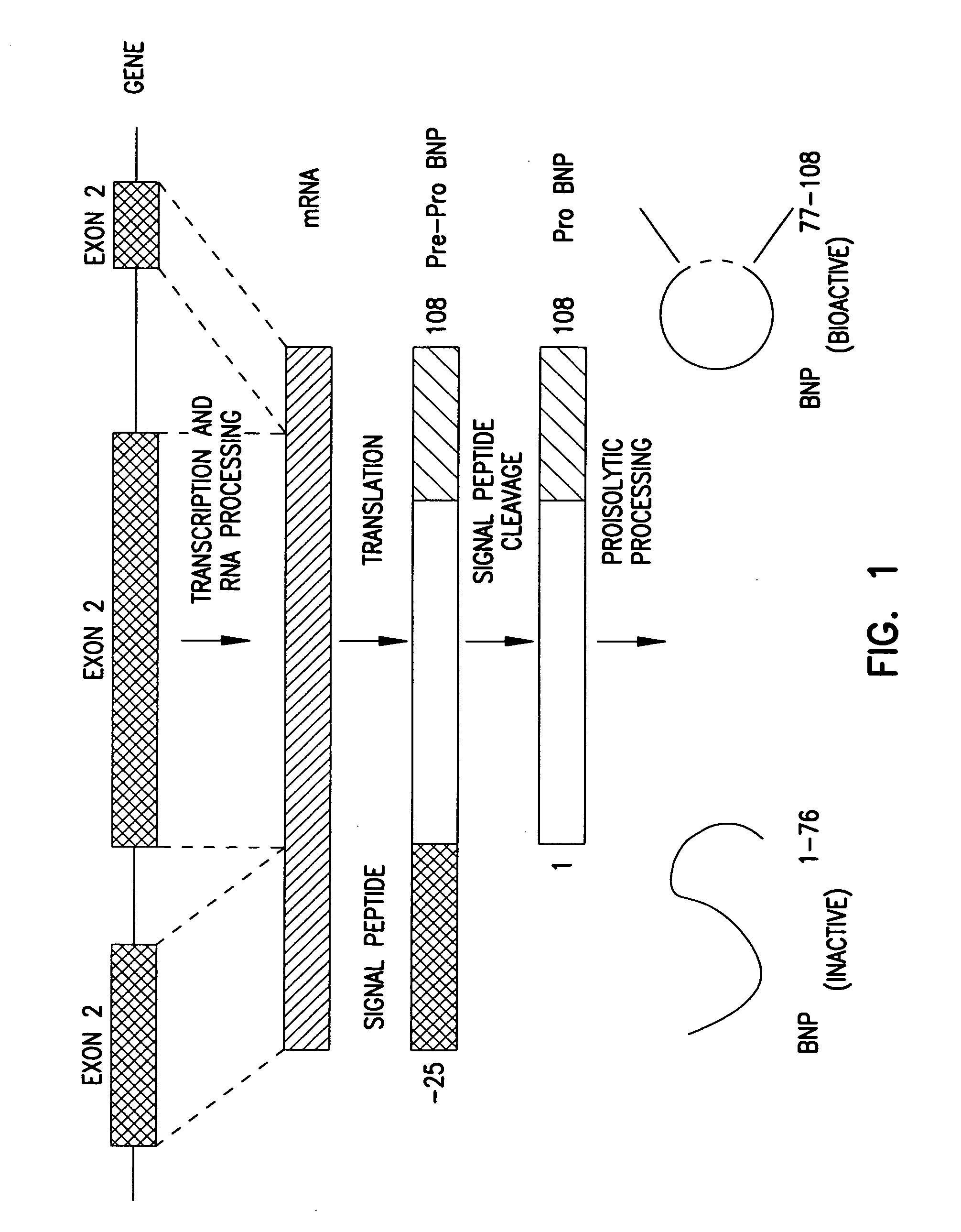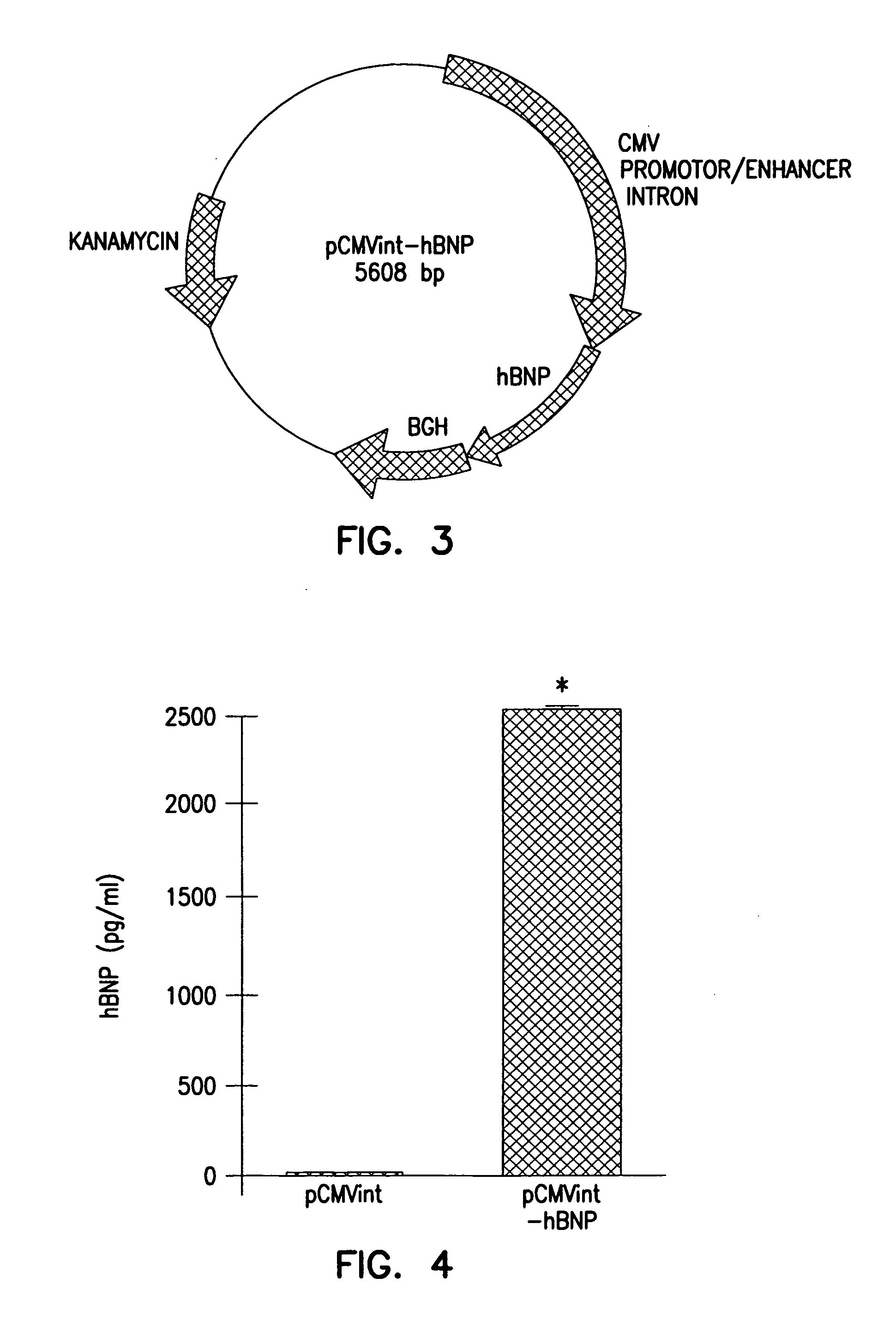Adenovirus vectors encoding brain natriuretic peptide
a technology of brain natriuretic peptide and adenovirus, which is applied in the direction of peptides, drug compositions, peptides/protein ingredients, etc., can solve the problems of 400,000 hospitalizations, renal unresponsiveness to anp, and many important limitations of current therapy, so as to inhibit or prevent pulmonary hypertension
- Summary
- Abstract
- Description
- Claims
- Application Information
AI Technical Summary
Benefits of technology
Problems solved by technology
Method used
Image
Examples
example 1
Preparation and Characterization of Natriuretic Peptide Encoding Gene Transfer Vectors
Methods
Western Blot Analysis
[0129] Samples of equal amounts of protein are denatured by boiling for 5 minutes and resolved by electrophoresis on a 12% SDS-polyacrylamide gel. Transfer of protein to a nitrocellulose membrane is carried out over 3 hours at 4° C. Immunoblotting is performed using a polyclonal rabbit anti-human BNP antibody or polyclonal anti-canine BNP antibody (Phoenix Pharmaceuticals, Mountain View, Calif.) at a dilution of 1:500 in nonfat milk / TBS-T buffer. Following washes, the membrane is subsequently probed with anti-rabbit secondary antibody conjugated to horseradish peroxidase (Amersham Life Sciences, Arlington Heights, Ill.) at a dilution of 1:5000 and developed with chemiluminescence (Supersignal, Pierce, Rockford, Ill.). The membrane is then exposed to X-ray film (Kodak, Rochester, N.Y.) and subsequently developed.
High Performance Gel Permeation Chromatography (HP-GP...
example 2
Delivery of BNP In Vivo to Normal Canines
Methods
[0146] Arterial blood for hormone analysis is collected in heparin and EDTA tubes and immediately placed on ice. After centrifugation at 2,500 rpm at 4° C., the plasma is decanted and stored at −80° C. until analysis. Specific plasma radioimmunoassays include canine and human (if necessary) ANP, BNP, CNP, cGMP, renin, and aldosterone. Radioimmunoassays are performed based upon well known methods. Urine for hormone analysis is also collected on ice. Urine samples are analyzed for BNP and cGMP via species-specific radioimmunoassays.
Echocardiographic Analysis
[0147] To determine the myocardial effects of local and systemic gene transfer of BNP, a two-dimensional and 2-D guided M-mode echocardiogram (Toshiba, Japan) is performed from the right peristernal window of each dog at baseline and weekly throughout the animal studies. Left ventricular end-diastolic (LVEDd) and end-systolic (LVESd) dimensions are measure...
example 3
A Canine ALVD Model
[0158] A modified model of pacing-induced ventricular dysfunction is employed to better characterize the temporal changes in local and circulating humoral factors during the progression of experimental heart failure from the initial stage of ventricular systolic failure (ALVD) through the phase of compensation to the terminal phase of overt CHF. Unlike the more conventional model of pacing-induced CHF, this modified model results in progressive ventricular systolic dysfunction with ventricular dilatation and hypertrophy (Stevens et al., 1996).
[0159] This model of ALVD is produced by incremental increases in rapid ventricular pacing over a period of a month. Ventricular pacing is initiated first at 180 beats per minute (bpm) and continued at this rate for ten days. This phase mimics human ALVD with early activation of the NPS, a maintenance of sodium balance, suppression of the renin angiotensin aldosterone system and a preserved natriuretic response to intravasc...
PUM
| Property | Measurement | Unit |
|---|---|---|
| ionic strength | aaaaa | aaaaa |
| pH | aaaaa | aaaaa |
| pH | aaaaa | aaaaa |
Abstract
Description
Claims
Application Information
 Login to View More
Login to View More - R&D
- Intellectual Property
- Life Sciences
- Materials
- Tech Scout
- Unparalleled Data Quality
- Higher Quality Content
- 60% Fewer Hallucinations
Browse by: Latest US Patents, China's latest patents, Technical Efficacy Thesaurus, Application Domain, Technology Topic, Popular Technical Reports.
© 2025 PatSnap. All rights reserved.Legal|Privacy policy|Modern Slavery Act Transparency Statement|Sitemap|About US| Contact US: help@patsnap.com



